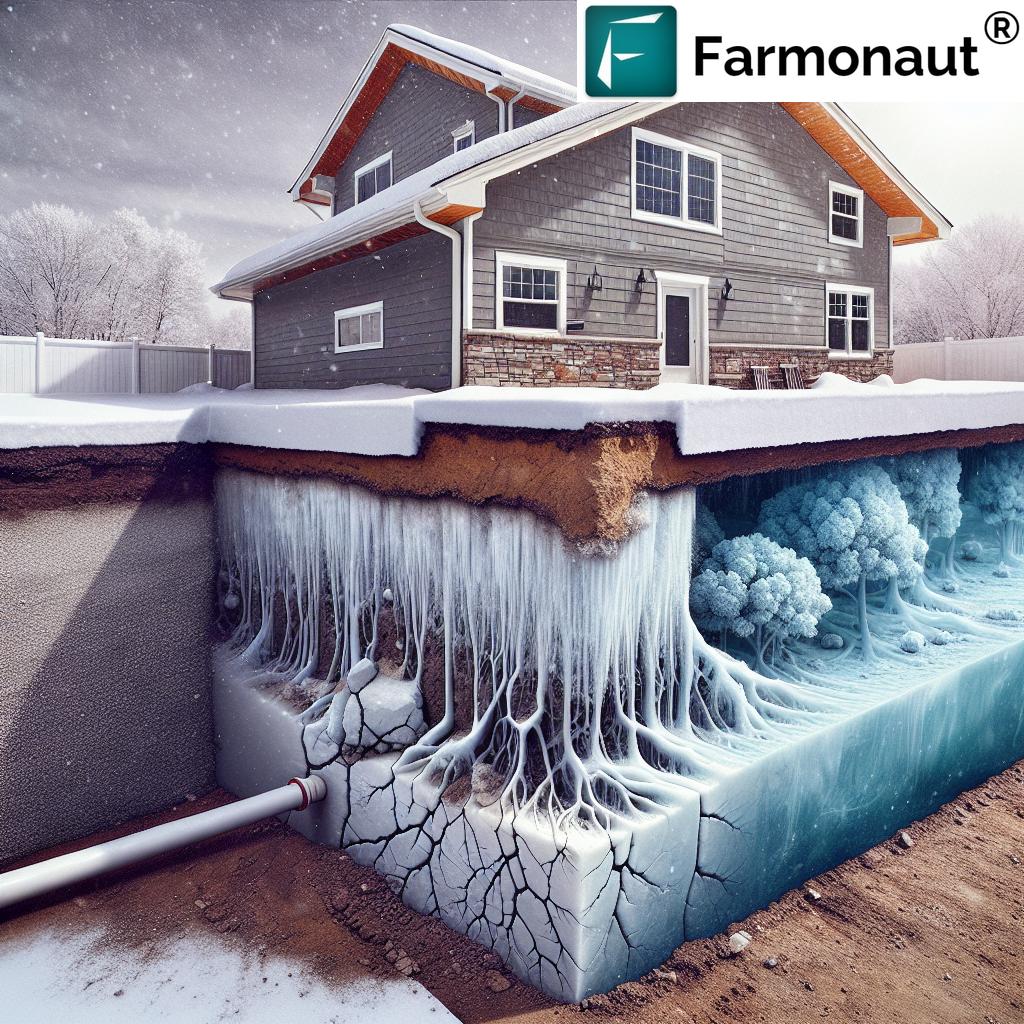Fargo Homeowners Guide: Prevent Foundation Cracks and Moisture Damage in Freezing Climates
“In Fargo, up to 90% of foundation cracks can be prevented with proper gutter maintenance and soil management.”

As winter’s icy grip tightens around Fargo, homeowners face a unique set of challenges when it comes to maintaining their property’s foundation. The freezing and thawing cycles characteristic of our region can wreak havoc on home structures, leading to foundation cracks and moisture damage. In this comprehensive guide, we’ll explore the impact of Fargo’s harsh climate on home foundations and provide you with essential strategies to protect your investment.
Understanding Foundation Cracks in Fargo’s Climate
Foundation cracks in Fargo homes are a common occurrence, particularly due to the recent cycles of freezing and thawing experienced in January. However, it’s crucial to understand that not all cracks indicate a serious problem. As home inspectors in our region often highlight, the prevalence of foundation cracks is largely attributed to the high moisture content in our soil.
When temperatures plummet below freezing, the moisture-rich soil tends to expand, potentially causing damage to home foundations. This phenomenon, known as frost heave, can exert significant pressure on foundation walls, leading to cracks and structural issues if left unchecked.
The Freeze-Thaw Cycle: A Foundation’s Nemesis
Fargo’s climate is characterized by extreme temperature fluctuations, especially during the transitional seasons. These freeze-thaw cycles can be particularly detrimental to home foundations. Here’s why:
- Soil Expansion: As temperatures drop, water in the soil freezes and expands, pushing against foundation walls.
- Thawing Effects: When temperatures rise, the frozen soil thaws, potentially causing settling and shifting of the foundation.
- Repeated Stress: The continuous cycle of freezing and thawing puts repetitive stress on foundation materials, leading to fatigue and eventual cracking.
To combat these challenges, homeowners need to be proactive in their approach to foundation maintenance and moisture management.
Preventing Moisture Damage: Key Strategies for Fargo Homeowners
Moisture is the primary culprit behind many foundation issues in our region. By implementing effective moisture control measures, you can significantly reduce the risk of foundation damage. Here are some essential tips:
- Proper Gutter Maintenance: Ensure your gutters are clear of debris and extend downspouts at least 5 feet away from your home’s foundation. This simple step can prevent water from pooling around your foundation.
- Grading and Landscaping: The soil around your foundation should slope away from the house at a rate of about 6 inches over a distance of 10 feet. This grading helps direct water away from your foundation.
- Install a French Drain: For homes with persistent moisture issues, a French drain system can be an effective solution to redirect groundwater away from the foundation.
- Maintain Consistent Soil Moisture: During dry periods, consider watering the soil around your foundation to prevent excessive drying and shrinkage, which can lead to settling.
By implementing these strategies, you can create a robust defense against moisture-related foundation damage.
Distinguishing Between Harmless Drywall Cracks and Serious Structural Issues
It’s natural for homeowners to feel concerned when they notice cracks in their walls. However, not all cracks are cause for alarm. Understanding the difference between cosmetic drywall cracks and serious structural issues can save you unnecessary stress and expense.
Harmless Drywall Cracks:
- Typically appear at stress points like corners of windows and doors
- Usually hairline in width and don’t widen over time
- Often caused by normal settling or seasonal changes in humidity
Potential Structural Issues:
- Cracks wider than 1/4 inch
- Horizontal cracks in foundation walls
- Stair-step cracks in brick or masonry
- Cracks that continue to widen over time
Lars Knobloch, a home inspector from Nordic Inspections, reassures homeowners that many cracks do not indicate a decline in structural integrity. “It doesn’t mean that your house is sinking. And that you should spend $30,000 on foundation repairs,” he explains. This perspective emphasizes the importance of not overreacting to minor cosmetic issues.
“Regular foundation inspections can reduce repair costs by up to 75% for homeowners in freezing climates like Fargo.”
Expert Insights: Managing Foundation Problems in Harsh Weather Conditions
Dealing with foundation issues in Fargo’s challenging climate requires a strategic approach. Here are some expert-recommended steps to manage and prevent foundation problems:
- Regular Inspections: Conduct bi-annual foundation inspections, ideally in spring and fall, to catch potential issues early.
- Monitor Existing Cracks: Use crack monitors to track any changes in the size or direction of existing cracks.
- Control Indoor Humidity: Maintain consistent indoor humidity levels to prevent excessive shrinking or swelling of wooden structural elements.
- Insulate Properly: Ensure adequate insulation in basements and crawl spaces to minimize temperature fluctuations that can affect the foundation.
- Address Drainage Issues Promptly: Fix any drainage problems around your property as soon as they’re identified to prevent water accumulation near the foundation.
By following these expert guidelines, you can significantly reduce the risk of severe foundation damage and maintain the structural integrity of your home.
Seasonal Foundation Maintenance Checklist
| Task | Spring | Summer | Fall | Winter |
|---|---|---|---|---|
| Gutter Cleaning | Clean 2-3 times | Check monthly | Clean 2-3 times | Monitor ice dams |
| Soil Grading Check | Inspect and adjust | Maintain slope | Final check before frost | Monitor snow buildup |
| Foundation Inspection | Thorough check | Monitor cracks | Pre-winter inspection | Check for frost heave |
| Crack Monitoring | Document changes | Ongoing observation | Compare to spring | Watch for new cracks |
| Moisture Control | Check humidity levels | Maintain dry perimeter | Prepare for moisture increase | Monitor indoor humidity |
| Drainage System Check | Clear winter debris | Ensure proper function | Prepare for freeze | Clear ice blockages |
This seasonal checklist provides a structured approach to foundation maintenance throughout the year. By following these guidelines, Fargo homeowners can stay ahead of potential issues and maintain their home’s structural integrity despite the challenging climate.
Protecting Your Foundation from Water Damage
Water is one of the most significant threats to your home’s foundation, especially in Fargo’s climate. Here are some additional strategies to protect your foundation from water damage:
- Install a Sump Pump: A properly functioning sump pump can be your last line of defense against basement flooding and foundation damage.
- Apply Waterproof Coatings: Consider applying waterproof sealants to your foundation walls, both inside and outside, to create an additional barrier against moisture.
- Maintain Your Plumbing: Regular plumbing maintenance can prevent leaks that might otherwise go unnoticed and cause foundation damage over time.
- Install Window Wells: For basement windows, install proper window wells with adequate drainage to prevent water from seeping in during heavy rains or snow melts.
Remember, preventing water damage is often more cost-effective than repairing the consequences of prolonged exposure to moisture.
Understanding the Signs of Potential Foundation Issues
Being able to recognize the early signs of foundation problems can save you from costly repairs down the line. Here are some indicators to watch for:
- Doors and Windows Sticking: If doors or windows that used to open smoothly start sticking, it could indicate foundation shifting.
- Uneven Floors: Use a level to check if your floors are sloping or uneven, which can be a sign of foundation settlement.
- Gaps Between Walls and Ceiling or Floor: These gaps can indicate that your foundation is moving or settling unevenly.
- Cracks in Exterior Brickwork: While some settling is normal, large or growing cracks in brick exteriors can signal foundation issues.
- Water Pooling Near the Foundation: This can lead to hydrostatic pressure and eventual foundation damage if not addressed.
If you notice any of these signs, it’s crucial to consult with a professional foundation expert for a thorough assessment.
The Role of Technology in Foundation Monitoring
In today’s digital age, technology plays an increasingly important role in home maintenance, including foundation monitoring. Here are some technological solutions that can aid in foundation care:
- Smart Water Sensors: Place these around your foundation to alert you of any moisture issues before they become severe.
- Digital Crack Monitors: These devices can precisely measure and track changes in crack width over time.
- Soil Moisture Sensors: Monitor the moisture content of the soil around your foundation to maintain optimal levels.
- Remote Monitoring Systems: Some advanced systems allow you to monitor your home’s foundation health from your smartphone.
While these technologies can be helpful, they should complement, not replace, regular professional inspections.
The Importance of Professional Assessment
While DIY maintenance is crucial, there comes a point when professional expertise is necessary. Here’s when to consider calling in a foundation specialist:
- When you notice sudden or significant changes in existing cracks
- If you observe multiple signs of foundation issues simultaneously
- Before purchasing a home, especially in areas prone to foundation problems
- If you’re planning major renovations that might affect the foundation
- After extreme weather events or natural disasters
A professional can provide a comprehensive assessment of your foundation’s health and recommend appropriate solutions if issues are found.
Spring Home Maintenance Checklist for Foundation Care
As winter recedes and spring approaches, it’s the perfect time to give your home’s foundation some extra attention. Here’s a checklist to help you prepare for the changing seasons:
- Inspect the Exterior: Walk around your home and look for any signs of winter damage, including cracks or shifting.
- Clean and Test Gutters: Ensure gutters are free of debris and direct water away from the foundation.
- Check Grading: Verify that the soil around your foundation still slopes away from the house.
- Examine Window Wells: Clean out any debris and check that drainage is functioning correctly.
- Test Sump Pump: Ensure your sump pump is working properly before the spring thaw begins.
- Inspect Basement or Crawl Space: Look for signs of moisture or new cracks that may have developed over winter.
- Trim Vegetation: Keep trees and shrubs trimmed back from your foundation to prevent root intrusion.
By following this checklist, you’ll be well-prepared to tackle any foundation issues that may have arisen during the winter months.
Frequently Asked Questions
Q: How often should I inspect my foundation?
A: We recommend conducting a thorough inspection at least twice a year, ideally in spring and fall. However, it’s good practice to keep an eye out for any changes throughout the year.
Q: Can I repair minor foundation cracks myself?
A: While small, hairline cracks can often be addressed with DIY methods, it’s always best to consult with a professional before attempting any repairs. They can ensure the crack is indeed minor and recommend the appropriate repair method.
Q: How much does foundation repair typically cost in Fargo?
A: The cost can vary widely depending on the extent of the damage and the required repairs. Minor repairs might cost a few hundred dollars, while major structural work could run into tens of thousands. This underscores the importance of preventative maintenance.
Q: Are there any plants I should avoid planting near my foundation?
A: Yes, avoid planting trees with aggressive root systems or water-hungry plants near your foundation. Opt for plants with shallow root systems and those that don’t require excessive watering.
Q: How can I tell if a crack is new or old?
A: New cracks often have sharp edges and might be lighter in color. Old cracks may have collected dirt or been previously filled. Using crack monitors can help you track changes over time.
Conclusion: Protecting Your Home’s Foundation in Fargo’s Freezing Climate
Maintaining your home’s foundation in Fargo’s challenging climate requires vigilance, regular maintenance, and a proactive approach. By understanding the unique challenges posed by our freezing temperatures and implementing the strategies outlined in this guide, you can significantly reduce the risk of foundation damage and protect your investment.
Remember, prevention is always better (and usually less expensive) than cure when it comes to foundation issues. Regular inspections, proper moisture management, and timely repairs are key to ensuring your home stands strong for years to come.
Don’t hesitate to seek professional help if you’re unsure about any aspect of your foundation’s health. With the right care and attention, your Fargo home can withstand the test of time and weather, providing a safe and comfortable haven for you and your family.
Stay proactive, stay informed, and keep your foundation strong!
Earn With Farmonaut: Affiliate Program
Earn 20% recurring commission with Farmonaut’s affiliate program by sharing your promo code and helping farmers save 10%. Onboard 10 Elite farmers monthly to earn a minimum of $148,000 annually—start now and grow your income!
For more information on agricultural technology and satellite-based farm management solutions, visit Farmonaut. Our platform offers advanced tools for crop health monitoring, AI-based advisory systems, and resource management to help farmers optimize their yields and reduce costs.
For developers interested in integrating our satellite and weather data into their systems, check out our API and API Developer Docs.




















